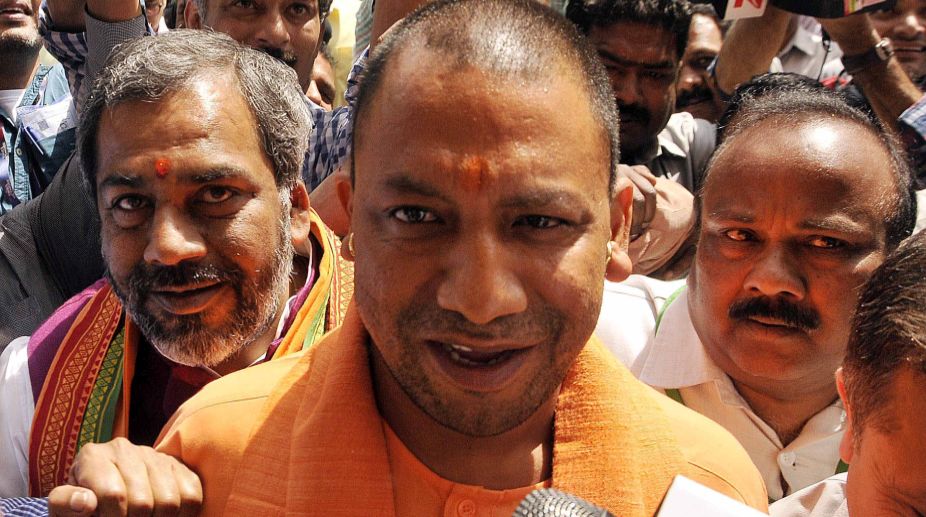Hema Malini calls herself a ‘gopi’ of Krishna, vows spiritual service in Mathura
Hema Malini, BJP MP from Mathura, pledges to serve spiritually and develop the region, emphasizing tourism, river restoration, and infrastructure.

Yogi Adityanath (PHOTO: SNS)
Uttar Pradesh Chief Minister Yogi Adityanath has barely settled in his hot and high-profile seat and inter-caste violent clashes have rocked some sensitive places in the most populous state of India. These merit firm and effective handling.
Saharanpur, the important west UP district, saw violence of the worst kind in the recent past, when Rajputs and Dalits clashed to assert supremacy over each other.
Violence erupted first on April 20 when a procession marking ‘Ambedkar Shobha Yatra’ held under the aegis of the Dalits was allegedly targeted by the Rajputs. That reportedly incurred the wrath of the Dalits who retaliated with fury. Then on May 5, there was another nasty clash between the two castes.
Advertisement
It has been alleged that the BJP made a calculated move to drive a wedge between the Dalits and the Muslims, purely aimed at electoral politics. However, local BJP MP Raghav Lakhanpal denies the charge rather vehemently and asserts that there was no move by the BJP to bring in Muslims. It’s therefore evident that the whole issue stands politicised and there is a clear and vertical division between the Rajputs and Dalits and society remains polarised.
There are also allegations that the BSP, miffed by the recent rout in the assembly elections, provoked Dalits to take on the upper caste – a charge that is contested by the BSP leadership. Authoritative sources, meanwhile, also point out that it’s all about electoral prospects and politics of the vote bank. Sadly enough, Saharanpur has not had local body elections for the last ten years allowing political parties to exploit the situation resulting in inter-caste riots.
Saharanpur has seen Hindu-Muslim riots in the past but caste-based violent incidents are gaining currency as there doesn’t seem to have been any sincere or concerted attempt by political players to narrow down their differences.
It is really ironical that violence erupted thrice in the last three weeks claiming two lives and saw so many houses set ablaze. A police post was also set ablaze by a frenzied mob. Such was the intensity of the clashes that senior police officers had to escape the onslaught by running away to safety. This indicates that the law and order machinery was caught unawares in coping with the extraordinary situation and the District Magistrate has admitted that local intelligence did not anticipate the extent of violence.
Both warring castes are using the names of their icons to the hilt. The Rajputs wanted to observe the birthday of Maharana Pratap which was violently objected to by the Dalits. Similarly, the Dalits wanted to hold a Mahapanchayat of the caste last Tuesday but fearing clashes, police did not accord permission thus further escalating the prospects of violence.
As the warring castes drifted apart over the past years due to lack of anticipation by the administration as also due to indifference, Saharanpur saw the emergence of Bheem Army, formed by the Dalits to take on their adversaries.
The architect of this army as well champion of the Dalit cause is a young lawyer named Chandrashekhar. He is seen as a firebrand leader of the Dalits who has also exploited other issues affecting the Dalits. Notably, he highlighted the suicide of Rohith Vermula and also brought into focus the Una incidents when Gaurakshaks allegedly beat up and perpetrated acts of violence on the Dalits. The division between the two castes is so sharp in Saharanpur that Bheem Army activists alleged that most objectionable and unparliamentary language was used in front of statues and portraits of Dr Ambedkar.
To infuse confidence amongst the people of Saharanpur, the UP government has removed two Superintendents of Police and brought in two new faces. Yet, people are gripped with fear and uncertainty. Saharanpur has a sizeable Dalit population and they are gripped by fear of attacks by the upper castes. The same feeling of uncertainty is nurtured by the Rajputs.
The recent incidents have unfortunately split Saharanpur into camps supporting two iconic leaders of history. This is a distortion as it conveys the message that Maharana Pratap stood for the Rajputs alone and Dr Ambedkar only for the Dalits. This misconception must be dispelled at the earliest for larger peace and caste amity. A tiny spark in Saharanpur has the potential to ignite sensitive districts in UP which have already been volatile. The writing on the wall must be carefully read by the new UP government or else it may be too late to control a very complex province already saddled with multiple challenges.
In the meantime, reports indicate that the eastern UP district of Deoria is tense following caste-linked problems. Immediate damage control is the need of the hour. CM Adityanath has chosen a competent DGP to head the huge police force. Public expectations of Mr Sulkhan Singh are high and many believe he will rein in any disturbing trend affecting peace in the state. Saharanpur seems to be a sort of test case from the law and order point of view. Should the government succeed here, the message will resonate in the state.
The writer is a retired IPS officer of the UP cadre and a Senior Fellow with the India Police Foundation. The views expressed are personal.
Advertisement